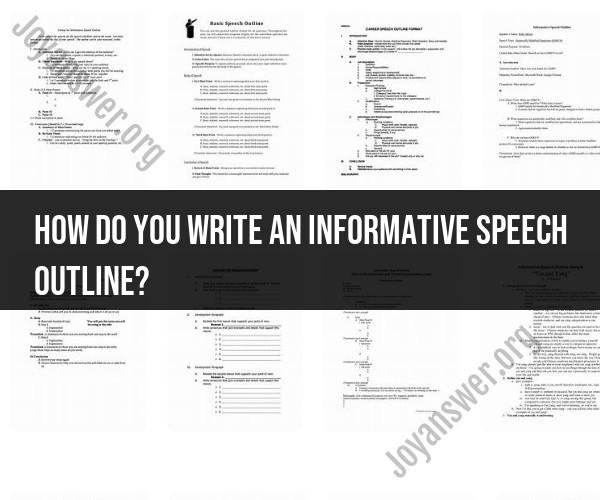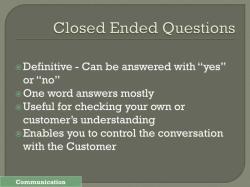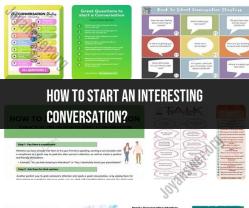How do you write an informative speech outline?
Writing an informative speech outline is an essential step in preparing to deliver a well-organized and engaging speech. Here's a step-by-step guide to help you create an effective outline:
Step 1: Choose a Topic
- Select a topic that you are knowledgeable about and passionate about, as this will make your speech more engaging and easier to research.
Step 2: Define Your Purpose
- Determine the primary purpose of your speech. Is it to inform, educate, persuade, or entertain? In most informative speeches, the primary purpose is to inform.
Step 3: Identify Your Audience
- Consider the interests, knowledge, and expectations of your audience. This will help you tailor your speech to their needs and level of understanding.
Step 4: Research Your Topic
- Gather relevant information from reliable sources such as books, articles, websites, and interviews. Make sure to take note of the sources for citation in your speech.
Step 5: Organize Your Ideas
- Create a clear and logical structure for your speech. The most common structure includes:
- Introduction: Hook, thesis statement, and preview of main points.
- Main Points: Typically, 2-4 main points that support your thesis statement.
- Subpoints: Supporting details, evidence, and examples for each main point.
- Conclusion: Summarize main points, restate the thesis, and provide a memorable closing statement.
Step 6: Create the Outline
I. Introduction
- Attention-Grabber (quote, anecdote, question, statistic, etc.)
- Thesis Statement (clearly state the main topic and purpose of your speech)
- Preview of Main Points (mention the main points you'll cover)
II. Main Point 1A. Subpoint 11. Supporting Detail2. Supporting DetailB. Subpoint 21. Supporting Detail2. Supporting Detail
III. Main Point 2A. Subpoint 11. Supporting Detail2. Supporting DetailB. Subpoint 21. Supporting Detail2. Supporting Detail
IV. Main Point 3 (if applicable)A. Subpoint 11. Supporting Detail2. Supporting DetailB. Subpoint 21. Supporting Detail2. Supporting Detail
V. Conclusion
- Restate Thesis Statement
- Summarize Main Points
- Memorable Closing Statement
Step 7: Transitions
- Ensure smooth transitions between the main points and subpoints. Transitions help your speech flow and make it easier for your audience to follow.
Step 8: Use Supporting Material
- Incorporate evidence, examples, statistics, and anecdotes to reinforce your main points. Be sure to cite your sources appropriately.
Step 9: Practice and Revise
- Practice delivering your speech using your outline. This will help you identify areas that need improvement, such as clarity, timing, and organization. Revise your outline and speech as needed.
Step 10: Finalize Your Outline
- Once you're confident in your speech, create a final version of your outline. Ensure it's clear, concise, and easy for you to follow while speaking.
Remember that an effective informative speech not only conveys information but also engages and educates the audience. Practice, clarity, and organization are key to a successful presentation.
Crafting an Effective Outline for an Informative Speech
An effective outline for an informative speech is one that is well-organized, clear, and concise. It should help you to deliver your speech in a logical and engaging way.
To craft an effective outline, start by clearly defining your topic and purpose. What do you want your audience to learn or understand by the end of your speech? Once you have a clear goal, you can begin to brainstorm the main points that you want to cover.
Once you have a list of main points, organize them in a logical order. Consider the flow of information and how each point builds on the previous one. You may also want to group related points together.
Once your outline is organized, add supporting evidence to each main point. This could include examples, statistics, or expert opinions.
Finally, write a conclusion that summarizes your main points and leaves your audience with something to think about.
Key Elements of an Informative Speech Outline
Here are the key elements of an informative speech outline:
- Introduction: The introduction should grab your audience's attention and introduce the topic of your speech. You should also state your thesis statement, which is the main point of your speech.
- Body: The body of your speech should consist of your main points and supporting evidence. Be sure to organize your information in a logical order and use transitions to help your audience follow along.
- Conclusion: The conclusion should summarize your main points and leave your audience with something to think about. You may also want to restate your thesis statement or call your audience to action.
Organizing Your Information for Clarity and Impact
When organizing your information for an informative speech, there are a few things to keep in mind:
- Use a clear and logical structure. Your outline should be easy to follow and understand. Each main point should build on the previous one, and your supporting evidence should be relevant and specific.
- Use transitions to help your audience follow along. Transitions are words and phrases that signal the beginning of a new point or idea. Some common transitions include "however," "in addition," "therefore," and "finally."
- Use visuals to support your points. Visuals such as images, charts, and graphs can help to make your speech more engaging and informative.
Examples of Informative Speech Outlines on Various Topics
Here are some examples of informative speech outlines on various topics:
Topic: The benefits of exercise
Thesis statement: Exercise has many benefits for both physical and mental health.
Main points:
- Exercise can help to reduce the risk of chronic diseases such as heart disease, stroke, and type 2 diabetes.
- Exercise can help to improve mental health and reduce stress and anxiety.
- Exercise can help to improve sleep quality.
- Exercise can help to increase energy levels and reduce fatigue.
Supporting evidence:
- Statistics on the benefits of exercise
- Expert opinions on the benefits of exercise
- Personal stories about the benefits of exercise
Conclusion:
- Restate thesis statement
- Call audience to action (e.g., encourage them to start exercising regularly)
Topic: The history of the internet
Thesis statement: The internet has revolutionized the way we communicate, learn, and do business.
Main points:
- The internet was developed in the 1960s by the US Department of Defense.
- The internet became available to the public in the 1990s.
- The internet has grown rapidly in recent years, with billions of users worldwide.
Supporting evidence:
- Historical facts about the development of the internet
- Statistics on the use of the internet
- Examples of how the internet has changed our lives
Conclusion:
- Restate thesis statement
- Discuss the future of the internet
Tips for Engaging Your Audience During an Informative Speech
Here are some tips for engaging your audience during an informative speech:
- Use a variety of delivery techniques. Vary your tone, volume, and pitch to keep your audience interested.
- Use humor and storytelling. Humor and storytelling are great ways to engage your audience and make your speech more memorable.
- Use visuals. Visuals such as images, charts, and graphs can help to make your speech more engaging and informative.
- Ask questions. Asking questions is a great way to involve your audience and get them thinking about your topic.
- Move around. Moving around the stage will help you to maintain your audience's attention.
By following these tips, you can craft an effective outline for your informative speech and deliver a presentation that is informative and engaging.












